
French cigarette card by Cigarettes Le Nil, no. 38. Photo: H. Manuel. Musidora as Irma Vep.

German postcard by Ross Verlag, Berlin, no. 1174/3, 1927-1928. Georges Biscot, presented in Germany as 'Biscot Meyer', in L'orpheline/The orphan (Louis Feuillade, 1921).

French Postcard, no. 171. Photo: Gaumont. Sandra Milowanoff and Aimé Simon-Girard in Le fils du filibustier/The Son of the Pirate (Louis Feuillade, 1922). Collection: Didier Hanson.

French postcard. Photo: Film Gaumont. Lucien Dalsace in Vindicta (Louis Feuillade, 1923).
The leading director of early French cinema
Louis Jean Feuillade was born in 1873 in Lunel in the Languedoc, France. He was the son of Barthélémy Feuillade, a modest wine merchant, and Marie Avesque. The young Louis quickly showed a taste for literature. He wrote numerous plays, dramas and vaudevilles, and published poems in the local press. He was trained as a journalist, but Feuillade first worked with his father and brother in the family wine shop and had his literary ambitions on the side. In 1898, after the death of his parents, he left the family business in the hands of his brother and went to Paris where he started as a journalist for the daily newspaper La Croix.
Feuillade managed to have a few plays performed, such as 'Le Clos', a verse play presented in Béziers in 1905, of which he was the co-author. The same year he presented a few scripts to Gaumont, a company originally focused on photography, but which was developing cinematographic ambitions. Alice Guy, the artistic director at Gaumont and also the first female director in the history of cinema, commissioned him to write his first screenplays in 1905.
Soon Feuillade became Guy's regular scriptwriter. After her marriage to the later director and producer Herbert Blaché in 1907, Alice Guy went to Berlin and later to New York. She suggested to Léon Gaumont that Feuillade be appointed artistic director. From 1 April 1907, he was responsible for the artistic choices of the French film company whose ambition was to compete with Pathé. Louis Feuillade would hold this position - in Paris until 1918, then in Nice - until his death.
Feuillade had the opportunity to direct films himself. In 1906, he breathed life into Alice Guy's ideas for short bullfighting films with Course de taureaux à Nîmes (Alice Guy, Louis Feuillade, 1906) with passes of the toreador Machaquito, shot in the Nîmes amphitheatre. His first personal film was the comedy C'est papa qui prend la purge/It was Dad who took the purge (1907). In 1910, to counterbalance Le Film d'art known for L'assassinat du duc de Guise/The Assassination of the Duke of Guise (André Calmettes, Charles Le Bargy, 1908), Louis Feuillade promoted the Gaumont series 'Le Film Esthétique', for which he directed religious works, Le Pater/The Lord's Prayer (1910), Les sept péchés capitaux/The Seven Deadly Sins (1910), La nativité/The Nativity (1910), and stories inspired by Greco-Roman civilisation. However, this attempt at 'high-brow' cinema was financially unsuccessful.
Instead, Feuillade became known in France with the serial film series La vie telle qu'elle est/Life as It Is (1911), a more realistic but somewhat melodramatic depiction of contemporary life. He often filmed with children and established them as series stars, including Clément Mary alias Bébé (more than 70 episodes, 1910-1913) and René Poyen alias Bout-de-Zan (more than 50 episodes, 1912-1916). Feuillade was a jack-of-all-trades. He made trick films, comedies, ancient dramas, bible films, exotic adventure films and police films. He brought naturalness to film and would become the leading director of early French cinema, especially with serials about criminals and detectives with realistic, sometimes even surrealistic backgrounds.

Spanish minicard series by Reclam Films, Mallorca, first episode, card 2 of 6. Photo: Gaumont. René Navarre and Jane Faber in Fantômas (Louis Feuillade, 1913). With a fake beard, Fantômas (René Navarre) observes Princess Danidoff (Jane Faber) in her hotel suite. He will rob her of her pearls and money and leave her a business card that only afterwards reveals its name: Fantômas.

Spanish minicards (collectors' cards). Reclam Films, Mallorca. René Navarre as Fantomas in a scene from the serial Fantomas, second series, Juve versus Fantômas/ Juve contre Fantômas (Louis Feuillade, Gaumont, 1913), card no. 6. Fantomas aka The Man in Black dynamites the villa in which Juve and Fandor are.
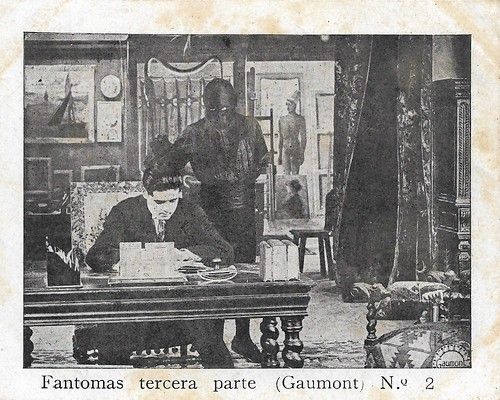
Spanish minicard by Reclam Films, Mallorca. Photo: Gaumont. Scene from the third episode of the French silent crime serial Fantomas, Le Mort qui tue (Louis Feuillade, Gaumont 1913). Fantomas (René Navarre), dressed as the Black Man, is about to chloroform the painter Jacques Dollon (André Luguet).
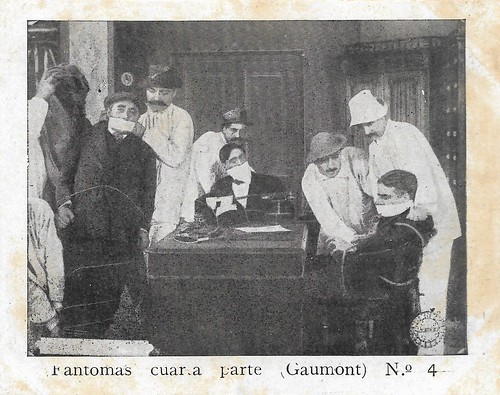
Spanish minicard by Reclam Films, Mallorca, card 4 of 6. Photo: Gaumont. Scene from Fantômas contre Fantômas (Louis Feuillade, G1914), the fourth episode of the serial Fantomas. Fantomas' gang, dressed as workmen, tie up the policemen, including the juge d'instruction Fuselier, and kidnap Juve (Edmund Breon).

Spanish minicard by Reclam Films, Mallorca, card 1 of 6. Photo: Gaumont. René Navarre in Le faux magistrat (Louis Feuillade, 1914), the fifth episode of the serial Fantomas. Pretending to be judge Pradier, Fantômas (René Navarre) orders the arrested gang members Paulet and L'Elève to make sure Juve will be killed.
A seductive and disturbing incarnation of the forces of evil
In 1913, Louis Feuillade adapted Marcel Allain and Pierre Souvestre's novel Fantômas for the big screen. The film serial Fantômas - À l'ombre de la guillotine/Fantomas (1913-1914) about the mysterious criminal Fantômas starring René Navarre made the hero of the successful detective novel series even more popular. Its swift-moving, intricate plot features a series of thrilling episodes involving clever disguises, trapdoors, kidnappings, hairbreadth escapes, and rooftop chases. René Navarre transformed into a crime emperor, while Georges Melchior was the journalist Fandor and Edmond Bréon the inspector Juve. Audiences were thrilled and kept coming back for more. The success was phenomenal. Five episodes were made: Fantômas (1913), Juve Contre Fantômas/Juve Against Fantomas (1913), Le Mort qui tue/The Dead Man Who Killed (1913), Fantômas contre Fantômas/Fantomas Against Fantomas (1914) and Le Faux Magistrat/The False Magistrate (1914).
Fantômas established Feuillade's popularity in both France and the United States. Then Pathé announced the French presentation of the episodic film Les Mystères de New York/The Exploits of Elaine (Louis J. Gasnier, George B. Seitz, Leopold Wharton, Theodore Wharton, 1914) presented in the form of a cine-novel: the public read the serial in the press before going to see the film in theatres. Gaumont's answer was Les Vampires/The Vampires (1915-1916), a ten-part series about the criminal organisation Les Vampires. Feuillade needed an actress capable of competing with Pearl White. He chose Musidora, who had been working with him since the previous year. She became Irma Vep, the muse of the mysterious 'Vampires' gang. Dressed in a tight-fitting black full-body suit, Irma Vep is a seductive and disturbing incarnation of the forces of evil. The lead actor, Édouard Mathé, replaced Navarre in the cast. As reporter Philippe Guérande, he struggles against these dark forces with the help of a repentant 'vampire', Mazamette, played by comedian Marcel Lévesque.
Les Vampires/The Vampires consists of 10 episodes presented over as many consecutive weeks. The film serial thrilled contemporary audiences not least because of the appearance of Musidora. The Surrealists were so fascinated by Feuillades' crime serials that Max Jacob founded a 'Société des Amis de Fantômas', which the entire group promptly joined. The characters Fantômas and Irma Vep, the femme fatale and strategist of crime embodied by Musidora from Les Vampires/The Vampires, are encountered in the collages of Max Ernst, poems by Paul Éluard and Robert Desnos (set to music by Kurt Weill) and films by Jean Cocteau. The motif of transformation and disguise is omnipresent in Surrealist cinema.
Feuillade then shot another very popular serial, Judex (12 episodes, 1916). He cast the actor René Cresté as the positive hero of the film series Judex, of which a sequel was made under the title La nouvelle mission de Judex/The New Mission of Judex (12 episodes, 1916-1917). Cresté played a daring detective with a sweeping black cape, a righter of wrongs who was the prototype of many future film heroes. The tremendous success of the |Judex series saved the French film industry, which had been threatened by competition from foreign imports.
René Cresté also appeared in two less-known Feuillade serials: Tih Minh (12 episodes, 1918) and Vendémiaire (1918). Especially Tih Minh with the exotic Hong Kong-born British actress Mary Harald is aesthetically pleasing. In Vendémiaire (1919), a hymn to the vine as a source of life and a return to the origins of the Hérault region, Louis Feuillade portrays an officer who has become blind as a result of a wound in battle and who takes in refugees from the First World War on his property. Feuillade's last crime serial was Barrabas (1919), with the veteran Gaston Michel in the role of the master criminal. Georges Biscot took over from Marcel Lévesque as the comic sidekick.
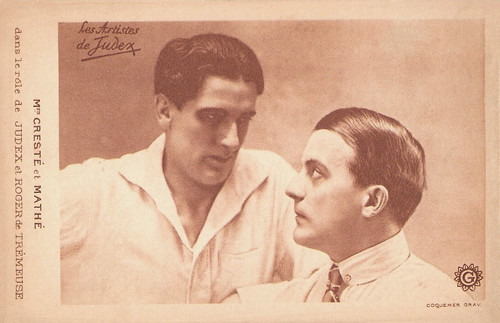
French postcard by Coquemer Gravures, Paris. Photo: Gaumont. René Cresté as Judex and Edouard Mathé in La nouvelle mission de Judex (Louis Feuillade 1917-1918).

French postcard by Coquemer Gravures, Paris. Photo: Gerschel / Gaumont. Marcel Levesque in the role of Coquentin in La nouvelle mission de Judex (Louis Feuillade, 1917-1918).

French postcard by Coquemer Gravures. Photo: Gaumont. René Cresté as Judex in La nouvelle mission de Judex (1917-1918).

French postcard in the 'Les Artistes de Judex' series by Coquemer Grav. Photo: Gaumont. Publicity still for La nouvelle mission de Judex (Louis Feuillade 1917-1918) with Yvette Andreyor as Jacqueline.
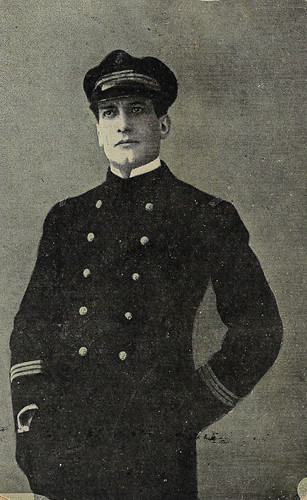
Spanish collector's card by Chocolate Pi, Barcelona, no. 1. Photo: Gaumont. René Cresté in La déserteuse (Louis Feuillade, 1917). The Spanish release title was Tortura de madre.
Persecuted innocence
After the First World War, the triumphant crime in Louis Feuillade's films gave way to persecuted innocence. He started to focus on melodramas such as Les Deux Gamines/The Two Girls (1921). The family story, which had previously been underlying Feuillade's episodic films, now came to the fore. To his usual cast of actors, the director added dancer Sandra Milowanoff, from Serge Diaghilev's Ballets Russes. Les Deux Gamines, presented at the Gaumont-Palace from January to April 1921, was a huge success. Feuillade's subsequent serials were always popular but he never achieved such a triumph as with Les Deux Gamines.
Feuillade's next two serials, L'Orpheline/The orphan (1918) and Parisette (1922) featured Sandra Milowanoff, but also a young, leading man named René Clair. Between these two serials, the indefatigable Feuillade directed, five comedies with Georges Biscot in the 'Belle Humeur' series, between 1921 and 1922. Although these comedies were not always very light, the series was always really effective and did not contradict its title.
Le Fils du Flibustier/The Son of the Pirate (1922) was his final serial in 12 episodes. It is more adventure-oriented and gives Aimé Simon-Girard, fresh from his success in Henri Diamant-Berger's Les Trois Mousquetaires/The Three Musketeers (1921), the opportunity to recompose a twirling and battling character in a work where reality and imagination are skilfully mixed. In 1922, he returned to the bullfighting thread and made with Musidora the films Sol y sombra/Sun and shadow (Jacques Lasseyne, Musidora, José Sobrado de Onega, 1922) and La Tierra de los toros/The Cradle of God (Fred LeRoy Granville, 1924), starring Cordoba-based rejoneador Antonio Cañero.
In 1923, the fashion for serials began to fade. Vindicta (1923), set in the eighteenth century in Provence and the Islands, had only five 'periods'. A six-year-old girl, Bouboule, discovered by Mistinguett, presented herself with fantastic spontaneity. From her first appearance in Le Gamin de Paris/Paris urchin (1923), the public had eyes only for her. Yet she had only a modest role in this film in which Sandra Milowanoff and René Poyen, the former Bout-de-Zan who had become a teenager, were the main characters. Feuillade devoted the whole of 1924 to his new young star, with René Poyen as her regular partner. After La Gosseline/The gossamer (1924) and La Fille bien gardée/The well-kept daughter (1924), he directed them in a six-part serial, L'Orphelin de Paris/The orphan of Paris (1924). Their two best films, however, are Pierrot, Pierrette (Maurice Champreux, Louis Feuillade, 1924) and Lucette (Maurice Champreux, Louis Feuillade, 1924), in which the two young stars both are very moving.
Exhausted by a life of uninterrupted work, Louis Feuillade was forced to take a complete rest in the summer of 1924. He made his last two films with the help of his son-in-law, Maurice Champreux. Only a few days after completing Le Stigmate/The Stigma, Louis Feuillade passed away in 1925 in Nice, at the age of 52. His death was a result of peritonitis. He is buried in the Saint-Gérard de Lunel cemetery. He was the father-in-law of Maurice Champreux and grandfather of Jacques Champreux. Forgotten with the arrival of sound film, Louis Feuillade's rehabilitation began after the Second World War thanks to Henri Langlois, who saved his films from 1936 onwards when the Cinémathèque française was founded.
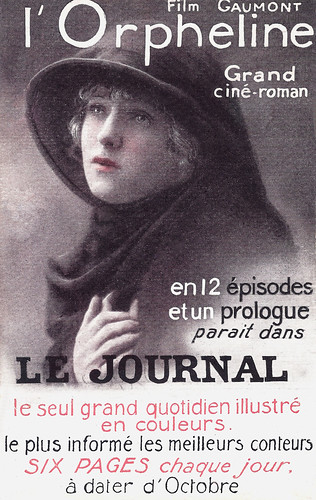
French postcard for the Gaumont serial L'Orphéline (Louis Feuillade 1921), starring Sandra Milowanoff.

Spanish collectors card in the Escenas selectas de cinematografía, Series, B, No. 20. Photo: Gaumont. Georges Biscot and Fernand Herrmann in Les deux gamines/The two kids (Louis Feuillade, 1921), presented in Spain as Las dos niñas de París.

Spanish minicard in the Escenas selectas de cinematografía series, series B, no. 3, for Juan Garcia, Chocolates Gavilan, Alicante. Fernand Herrmann and Bernard Derigal in Le fils du flibustier/The buccaneer's son (Louis Feuillade, 1922). The Spanish title is El hijo del pirata.

Spanish minicard in the Escenas selectas de cinematografía series, series B, no. 4, for Juan Garcia, Chocolates Gavilan, Alicante. Georges Biscot in Le fils du flibustier/The buccaneer's son (Louis Feuillade, 1922). The Spanish title is El hijo del pirata.

Spanish minicard in the Escenas selectas de cinematografía series, series B, no. 13, for Juan Garcia, Chocolates Gavilan, Alicante. René Poyen (Bout de Zan) as war orphan Joseph (left) in Le gamin de Paris/Paris urchin (Louis Feuillade, 1923). The little girl he holds was Bouboule as Gaby, the general was played by Adolphe Candé, and the lady at right, Madame de Mersange, by Renée van Delly. Spanish title is El muchacho de Paris. As a child star, René Poyen was known in France as Bout de Zan and in Spain as Minutiyo.
Sources: Britannica, Wikipedia (Dutch, German, English, and French), and IMDb.
For Ivo. Congratulations!
No comments:
Post a Comment